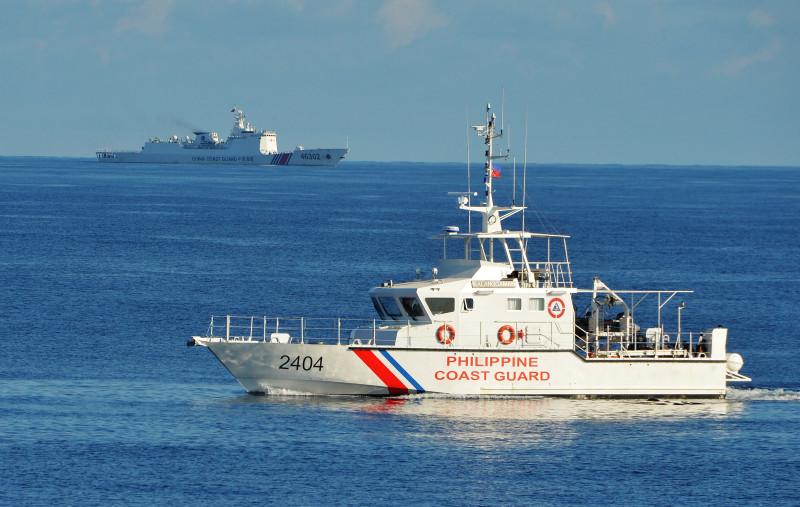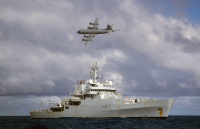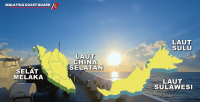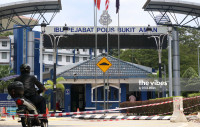THE 2023 China Standard Map issued by the country’s Natural Resources Ministry has raised the ire of many countries, including India and Malaysia, and is not a new playbook by Beijing, as this has been ongoing for years.
The new map has reaffirmed Beijing’s claim and dominance over Arunachal Pradesh, the Aksai Chin region, Taiwan, and the South China Sea, all of which remain disputed and controversial.
It includes maritime areas within Malaysia’s exclusive economic zone (EEZ) near Sabah and Sarawak, Brunei, the Philippines, Indonesia, and Vietnam.
The timing of this release has invited new scrutiny, in light of rising tensions in the region and upcoming geopolitical events that will compel Beijing to defend its interests and maximise its gains. Three possible main factors are involved.
The first is potentially Taiwanese Vice President and presidential hopeful William Lai’s recent stopovers in New York and San Francisco, and his conventional hardline approach in Taiwan’s status and its ties with mainland China have all angered Beijing, and this is another tool in piling on the pressure on Taiwan on top of the usual new normal of hard power intimidation and encirclement of the island.
Dozens and dozens of Chinese air force planes had crossed the Taiwan Straits median line since the stopovers in the US, providing a continuation of the new coercion tactics in pressuring and warning the populace in the island against any new fundamental change in its posturing with China. This is also to reduce any increase of support for the presidential hopeful and the current incumbent party, the DPP.
The release is timed to suit this new development, in sending a defiant and deterrent message to all claimant parties including Taiwan, and for Taiwan, it serves as a two-pronged message in including a significant portion of Malaysian waters near Sabah and Sarawak, as well as various regions in India claimed by China.
Secondly, the release of the treated radioactive water from the stricken Fukushima Daiichi nuclear plant has been seized upon by China to discredit Japan for convenient geopolitical gains, ignoring the obvious scientific evidence presented. Recent moves to consolidate security ties between Seoul and Tokyo are seen as hostile and threatening to Beijing’s security fears, and Beijing will need to send a clear and credible message to rising containment capacity by both the West and its regional allies.
While Beijing is further squeezed by its internal economic decline and the aftermath of the tech embargo by the West, prospects are worsened by the inaugural tripartite Camp David defence pact. While Beijing has gained ground in Southeast Asia in elevating its soft power narrative and hard power postures to enhance trust, it continues to receive dwindling perception and acceptance in its Eastern neighbours.
Beijing’s worst fear of a consolidated security pact has come true, and the prospects of an expanded Camp David alliance or an enlarged Quad in the form of a mini or Asian Nato further accelerate Beijing’s hardened playbook and antagonising behaviours.
This move to discredit Tokyo is an opportunistic and convenient pretext amidst growing tensions in the South China Sea and the growing counterbalancing forces and solidarity shown by the West and other players for Manila.
Thirdly, the upcoming G20 summit to be hosted by India remains another platform seen by Beijing as squeezing its rise and interests, in which China will need to build on its momentum of capturing the Global South and portraying itself as the undisputed leader of developing countries and in creating a new bulwark of anti-Western order and sphere of influence. India is increasingly being courted in a more holistic manner by the US-led West, and China will want to send another two-pronged message to Delhi and Washington as well as regional neighbours in South and Central Asia that Beijing still holds the dominant economic and security upper hand, although its economic credentials have taken a serious hit.
The coming openings for China’s consolidation of influence and power expansion capabilities including the G-77 event and the recently concluded BRICS Summit are seen as crucial progressive tools for Beijing’s continuous anti-West narrative, in enhancing its flurry of strategic moves including the de-dollarisation movement and an expansive soft power and messaging capacity in upping the positive image of China and playing the victim card in painting the US-led West as the main antagonist and instigator of tensions in chokepoints across the region.
The recent revelation by Meta on Tuesday that it had disrupted a disinformation campaign linked to Chinese law enforcement described as the largest known cross-platform covert influence operation in the world, remains a case in point. The influence network generated positive posts about China, while also attempting to spread negative commentary about the US and disinformation in multiple languages about the origins of the Covid-19 pandemic, as reported by Meta.
Dispelling the West and protecting China’s ‘backyard’
The South China Sea is critical for Beijing to protect its near-water dominance and to secure the area from the West, treating it as its own backyard. It sits at the crossroads of all major continents and is the vital linkway connecting Asia to Europe and to the Middle East.
It is home to around a third of the total world trade with more than US$5 trillion (RM23.2 trillion) as well as estimated oil and gas reserves of more than seven billion barrels. While strategic fossil fuel resources remain one of the critical factors at play in the realm of the dispute and conflict, the overarching tool of priority remains the crucial maritime and geopolitical security that lies at the heart of regional powers’ playbook. China’s self-delineated maritime border, the so called Nine-Dash Line, remains at the forefront of regional dispute which overlaps with all other claimants’ exclusive economic zones.
The main archipelagos of Spratly, Paracel, the Scarborough Shoal as well as the Macclesfield Bank, are all claimed by Beijing, and are strengthened by its increasing militarisation activities and ventures backed by its increasing might of its coast guard capacity and the vast fishing fleet.
China’s intentions in the South China Sea are shaped through a mixture of different factors, including importance of economic, trade, resources and maritime considerations. Chief among that will be the central mantra of reaffirming its survival and security needs, securing its so-called backyard and challenging the US in its continental home. Around 80% of China’s crude oil needs to pass through the South China Sea, and the substantial oil reserves are still attractive to Beijing.
However, the pursuit of dominance there transcends economic importance per se. China treats the region as its backyard and by increasing its area denial/anti-access (A2/AD) capacity, it hopes to thwart the West’s presence especially in the First Island Chain that has choked its Pacific Ocean ambition. Establishing a clear dominance in the South China Sea thus remains vital for Beijing to secure its Taiwan ambition, deterring the chain of support from Australia in the case of a full-blown Taiwan conflict, and paving the way for its Pacific expansion.
This rising assertive path chosen by Beijing is based on a three-pronged factor. First, the fast-closing window and timeframe for Xi to execute his ultimate Chinese Dream plan for Taiwan unification.
Second, the increasing counterforce capacities by the US in thwarting Beijing’s moves have challenged Beijing’s near-term capacities.
Thirdly, the declining effectiveness of deterrence and influence of Asean itself in showing real and credible opposition to Beijing’s inroads, will give a clearer path for Beijing to reassert its push.
Three Warfare Exercises
Beijing’s agenda in securing its dominance in the South China Sea is pillared by the tenet of the Three Warfare Exercises, a term coined by scholars to be a key part in the playbook on the South China Sea. The First Warfare is a propaganda campaign, in expanding on the narrative and declaring to the world that the South China Sea belonged to China since antiquity, and it remains its historical pride and right. This is reflected in the position paper submitted to the Hague during the arbitration in 2016, where it was stated that the influence of Chinese activities spanned back over more than 2,000 years and that it was the first country to discover, exploit and to name the islands and the territories at the sea.
The Second Warfare involves the usage of coercive tools to coerce and intimidate other players and claimants. The speedy militarisation and the depth of the hard power calculations through the building of overwhelming military power and in extending the power gap with the current regional players. In just around three years from 2013 to 2015, Beijing has built three air and naval bases that were gigantic in size, providing a power intimidation and message to regional players that they remain no match for Beijing’s hard power capacity.
The Third Warfare signals the intent of using China’s legal argument and perspective that its rights to the South China Sea are legitimate and that they predate the 1982 UN Convention on the Law of the Sea (Unclos). This is a reflection of China’s continuing effort to spearhead “Chinese characteristics” into international law, and in moulding the international law and sphere of narrative that is based on the Chinese version and narrative.
China now has the world’s largest navy and coastguard, as a result of a tenfold increase in military spending since 1995, expanding its naval footprint throughout the world beyond the South China Sea. The Ream base in Cambodia provides additional support for Beijing’s claim in the sea, adding to the numerous artificial islands already built and the rapid militarisation of the area that will give it effective control on this critical corridor.
China’s nuclear ballistic missile submarines (SSBN) are now prowling the South China Sea at all times, ensuring a second-strike capacity against combined deterrence forces of the US and the West in the event of a full-blown Taiwan conflict.
The new JL-3 class submarines will allow China to cement its bastion strategy in the South China Sea to have the capacity to protect its swarm of SSBNs using existing land-based anti-missile systems and its fortified islands, without the need for the SSBNs to sail into the Western Pacific to launch their submarine-launched ballistic missiles (SLBMs). This new range capacity of the SLBMs, with more than 10,000km, will provide risks for continental US, Hawaii and Alaska, and with these being used as a second-strike capacity for any contingency.
Increasing bellicosity and intimidation shown in the chokepoints including the laser incident and the water cannoning of Philippines’ vessels project a consistent approach of Beijing in its divide-and-rule approach, using hard power intimidation and a mixture of different models including salami slicing, grey zone tactics and cabbage strategy in reinforcing its South China Sea dominance, with its coast guard warfare being the at the forefront.
Sensing the futility of Asean and regional players’ policy responses due to their lack of deterrent capacity and the ingrained economic dependence on its economic support, it gives Beijing greater openings for consolidation of its military and security interests in these critical zones.
Various confidence-building measures and conflict prevention mechanisms have also failed to address the core causes of regional tensions, which have further escalated security dilemmas and arms races. Beijing has accused the West including the various deterrent mechanisms including Aukus and Quad as destabilising and the primary cause of regional tensions and arms build-up.
However, Beijing’s increasing hard power projection and intimidation are what caused regional jitters and fears in the first place, sparking the natural reactions of deterrent capacities and the unyielding drive to secure the importance of a rules-based order and maintaining peace and stability.
Unless the region can jettison its archaic policy and affiliation trap, Beijing’s regional reign looks difficult to be reined in without a holistic and integrated regional unity in standing up for a free and open maritime route based on established norms and international law and a rules-based order. – The Vibes, August 31, 2023
Collins Chong Yew Keat reads The Vibes





















